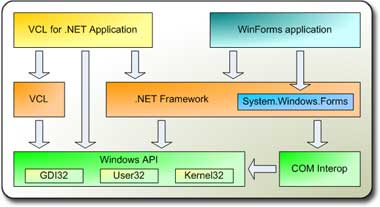
| Home | | | Shorter Path | | | About Me |
|
Delphi and the myth of .NET puritySunday, May 30, 2004 02:27 PM Scott Hanselman writes in an MSDN article, titled "The Myth of .NET Purity, Reloaded":
The article discusses the myth of ".NET Purity" - the idea that all .NET application must rely only on the .NET framework, without any COM interoperability or Win32 API calls. It's a myth because, as Hanselman reminds us, the framework itself relies heavily on both COM interop and Win32 API functions. The .NET framework is indeed a platform, but it's not an operating system. Many people get the two concepts confused, and assume the .NET framework will eventually replace Windows. If that was the case, Hanselman notes, Microsoft would have marginalized their investment in the Windows platform. Instead, Microsoft is actively developing the operating system, while exposing many new capabilities as managed APIs. That's because Windows isn't going away, but there are significant advantages to managed code and to the Common Language Runtime. Managed code relieves developers of many of the difficult and error-prone tasks of memory management, lifetime management, and access to system services. The CLR provides a common base for interoperability, and the FCL provides a rich, language-independent and object-oriented API. The article makes two very good points:
It occurred to me that the article makes a very strong case for Borland Delphi and VCL for .NET. Delphi for .NET produces 100% managed IL code, and can be used to create any type of .NET application. A Win32 version of Delphi is also available, and produces 100% native code. Delphi for Win32's RAD capabilities are based on the VCL, a powerful and mature component library, comparable with .NET's WinForms. There are a lot of VCL-based applications out there, and lots of components, too. The VCL was originally developed for Windows, and relies heavily on Win32 API function and messages. While there are many similarities between the .NET framework and the VCL (hardly surprising, as some of the designers of the VCL were also involved in the framework's design), the frameworks are too different to be made compatible. It would not be feasible, for example, to rewrite the VCL to sit on top of WinForms. There is nothing, however, preventing a VCL application from using any of the other .NET classes. In fact, it's even possible to host WinForms controls on a VCL form. By building a VCL for .NET application, you lose nothing the .NET framework has to offer, and you can gain a lot. Also remember that if you still don't want to use the VCL, that's OK. Delphi fully supports the development of WinForms applications. For more information about VCL for .NET and its purpose, see Danny Thorpe's article at BDN. Let's consider three groups of developers, and see what Delphi and the VCL can do for them: 1. Delphi developers targeting both Win32 and .NET
2. Delphi developers targeting only .NET
3. Non-Delphi developers (or potential Delphi developers)
In short, not only is Delphi an attractive option for .NET developers, but the VCL is also much more than a compatibility layer. The only thing missing is the availability of the VCL for other .NET languages. Phil Gilmore suggests adding the VCL to C#Builder. This makes a lot of sense: Delphi for .NET and C#Builder already share an IDE, so integrating the VCL form designer doesn't seem impossible. C# developers will finally be able to choose between frameworks. It might even be possible to support other languages, although making the form designer support them might be difficult. Still, even today the VCL's form designer already supports both Delphi and C++ (on Win32 and Linux). Sounds interesting. |
||||||||||||||||||||||||||||||||||||||||||||||||||||
Copyright 2004 Yorai Aminov
